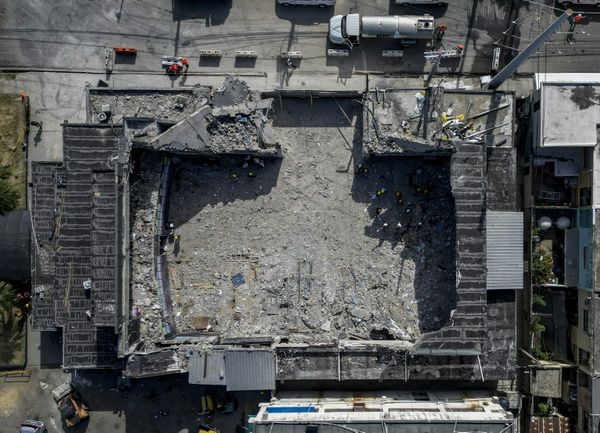
Cicadas sang a chorus as the forest opened out. I peered into the darkness and traced the distant contour of a monumental religious complex, a remarkable feat of human civilisation. Keyed up with my first visit, I crossed a floating bridge, a soon-to-be-dismantled construction, over a large moat in the midst of lush vegetation. Before dawn, I arrived at Angkor Wat.
"Sour sdey [hello]," said Pheakdey, a local guide, in his native language when a group of journalists joined other early risers in catching daybreak. All stood in awe of the world's largest temple. After two years of the pandemic, Cambodia officially reopened late last year.
"It is getting better," he said, "Around 1,000 tourists are coming [to Angkor Wat] at the moment."
Built in the 12th century by King Suryavarman II, the temple is modelled on Mount Meru, the abode of Hindu gods encircled by water representing the cosmic ocean. It is one of the main temples in Angkor, the capital of the Khmer Empire (802-1431). After its fall, the heartland moved to Phnom Penh, the capital of modern-day Cambodia. Angkor was added to the World Heritage List in 1992.
Each floor of the three-tiered temple features different facilities, including galleries, swimming pools and libraries. Walls depict epic battles and figures like apsaras (celestial nymphs in Hindu mythology). Upon closer inspection though, the temple bears signs of damage. Lichen dapple its structure made of sandstone and laterite. German and Japanese archaeological teams have been restoring it.
"It [lichen] absorb and erode stones. When they remove it, they can't use a chemical substance like in 1993. You can see those covers eroded because of the strong chemical. [Instead], they use a natural way. They have bamboo, a toothbrush and linen, which is a very old way of doing the job. Stones are having a break like human beings," he said.

After breakfast from a picnic hamper, I set off for another temple, Ta Prohm, in the outlying jungle. Phorn, a local scooter driver and law freshman, took me on her vehicle through a winding and bumpy road. She told me that she works during the day and studies at night. If there are more tourists, she will be able to save enough money for her master's degree in law.
Unlike Angkor Wat, the royal monastery Ta Prohm is being taken over by the wild. Built in the late 12th century by King Jayavarman VII, the temple was dedicated to his mother. At the centre was once her statue, but it is now at the Louvre Museum in Paris. In front of the site, the body of a naga is left on the ground and a lion statue is gone.
"Most parts of the building are in ruins because of the tree root," said Pengthai, a local guide, while pointing to a fig tree spreading tentacles through the chamber. "They are now [bound] together. It is hard to separate them. If we cut the tree, the temple will be ruined. We can just build reinforcements."
India has been funding the restoration project. Some workers are cutting down overgrown trees, which endanger the structure under threat of damage from footfall. Others are mending stones here and there.
Pengthai said a new technique involves drilling them and putting glue with metal inside, but broken stones will be replaced with natural ones. Cement and concrete are avoided.

"A lot of work is now going on around the temple. It took 40 years to build, but will maybe take 60 years to restore because they have to figure out each block of stone, move it down [for maintenance] and put it back together. It is like a domino," he said.
I continued to explore other sites, including the Gate of the Dead and Bayon. As early as the 20th century, the remains of Angkor became a popular tourist destination. After years of internal conflict, including the communist Khmer Rouge under Pol Pot from 1975-1979, Cambodia opened up to the outside world in the 1990s. It saw an all-time record of more than 6.61 million foreign visitors in 2019.
I stayed three nights at Raffles Grand Hotel d'Angkor. The hotel reopened in June for the first time after almost three years. Located on the main thoroughfare to the archaeological park, the art deco-style hotel has stood the test of time for 90 years. Painted in elegant white, it stretches its symmetrical wings. Meanwhile, a raised portico juts out from an entrance, overlooking a plantation ground.
An iron-cage elevator took me to the 4th floor as staff said the hotel underwent renovation in 2019. My chamber was a living room-bedroom combo. It included a large comfy bed, a reading armchair, a writing desk and an old rotary telephone (a butler taught me to use it). From my own balcony, I enjoyed the panoramic view of the street, the garden and the royal residence.

"It is a magnificent feeling to bring this enchanting hotel back to life," said general manager Dennis de Groot. "The Grand Hotel is a national treasure, and its storied history is a testament to Cambodia's colourful past. It was originally built as a rest stop for archaeologists and adventurers seeking to explore the ancient kingdom of Angkor."
Next to the checker-tiled lobby, the Elephant Bar earns its name from the fact that guests once travelled to the hotel by the animal. Chenty, a waitress, said it is her first workplace and a dream job. She has been working here since 1999. After more than two years of the pandemic, she feels more than happy to return to work. "The number of visitors to Siem Reap is increasing. I hope that the situation will get better," she said.
It is hard to separate the history of the hotel from the ups and downs of Cambodia. Nobody can give a better historical account than Saravann Mouth, a resident historian and butler manager. He is a survivor of the communist regime of the 1970s. At the time, he became an orphan, separated from his mother and forced to collect cow dung for survival.
The property came out of a proposal to build five hotels in French Indochina, including Siem Reap. Overseen by French architect Ernest Hébrard, the Grand Hotel d'Angkor officially opened in 1932, welcoming royal members, dignitaries and film stars. Charlie Chaplin and Paulette Goddard nested here in 1936. Other notable guests include Jacqueline Kennedy, the former wife of the late president Kennedy, in 1967.

However, the hotel experienced a long period of interruption. In 1970, Prime Minister Lon Nol staged a coup against Prince Norodom Sihanouk. Senior military staff occupied the hotel. In 1975, the Khmer Rouge took over, forcing millions of people to work on rural farms. Pol Pot cadres took up residence. In the 1980s, Vietnamese forces occupied the property.
It was in the 1990s that the hotel resumed its services. Raffles began renovation and reopened on Dec 30, 1997. It now comes with a total of 119 rooms and many facilities, including restaurants, swimming pools and souvenir shops. It offers curated tours and programmes to enrich vacationers. Above all, it pays meticulous attention to creative expression. I came across its magazine where writers are invited to stay and craft marvellous tales.
Come evening, the hotel arranged a culinary tour of the neighbourhood. At the Sugar Palm, I enjoyed simple, home-cooked dishes, particularly Khmer satay, fish salad and fish amok (steamed fish curry). Diners had an opportunity to meet chef Kethana Dunnet, who learned to cook from her mother and grandmother while growing up in Phnom Penh.
Unlike the fast-paced capital, Siem Reap still retains leisurely, traditional charm, attracting new faces from neighbouring countries and further afield. Hailing from New Zealand, Dean Williams, a former radio journalist, has run Miss Wong, the town's first cocktail bar, for 14 years. However, the coronavirus pandemic forced the closure of his bar for 10 months.

"I had to keep the whole team on with no income. I had to put staff on a lower salary. We had to survive. My staff have been with me, some of them for 14 years. I have seen them go to university, get married, buy land, have children and build houses. They are my family," he said.
Located in a shophouse, Miss Wong draws inspiration from the eponymous work of Vladimir Tretchikoff, an artist who fled the Russian Revolution and lived in Harbin and Shanghai. After imprisonment during World War II, he eventually settled in South Africa, where he became one of the most popular artists in the 20th century.
Dean reopened his bar in October last year. At the time, there were very few flights: one flight a day from Singapore and one flight a week from South Korea. With the resurgence in international travel, the number of tourists is increasing, particularly those from Bangkok.
"I am confident that Siem Reap remains a top destination," he said.

























Travel info
- According to the Embassy of Cambodia to Thailand, Thais with ordinary passports receive visa exemption to Cambodia for 14 days of stay. An international vaccine certificate is also required to enter the country.
- From March 17 onwards, passengers are not required to show negative Covid-19 PCR test results and do a rapid antigen test on arrival. However, they must show vaccine certificates. The electronic version can be obtained from the Mor Prom application in only one day. Visit cambodiaembassyinthailand.wordpress.com for further details.







